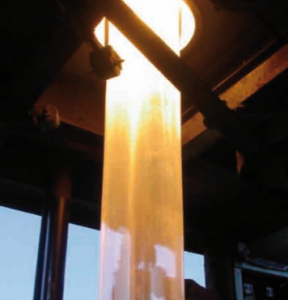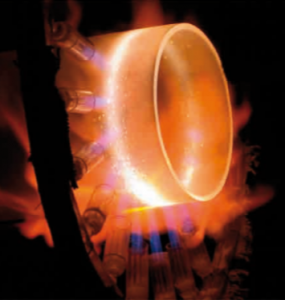Quartz is a unique material, due to its high purity level of SiO2 and to its mechanical, electrical, thermal, chemical and optical properties.
Helios Quartz produces transparent, translucent and opaque quartz glass arti cles with different production techniques and raw materials:
cles with different production techniques and raw materials:
- One Step production method
This is the most common method used to produce quartz glass in a continuous process. The quartz sand is melted in a tungsten crucible that contains electrical heating elements; the fused material flows down from the crucible through a bottom mould where it is shaped into tubes, plates and rods. By this production method and with the proper raw materials selection we are able to obtain finished goods with high purity, excellent mechanical, thermal and optical properties and low OH content.
-
Oxygen hydrogen flame fusion production method
The fusion process occurs through a hydrogen/oxygen (H2/O2) flame. The raw material is heated up through a H2/O2 flame until it melts. In this way, we obtain a lingot, which can be shaped into tubes, rods, disks, plates. The OH content is stable at 150 ppm., this value cannot be reduced through annealing processes. The optical properties of these qualities of quartz glass are excellent, in fact through the use of this type of process we can guarantee a finished good virtually free from bubbles content.
- Electric vacuum two-step fusion method
The first production step consists in a quartz glass lingot that is obtained through an electrical vacuum fusion furnace; then it is fused again through an induction furnace to become tubes, rods and plates. All the heater moulds and crucibles of this producing method are made of high purity graphite. The quartz glass produced through this method has an excellent thermal stability, a very good resistance to high temperature, a great transmission from the UV to the IR range of wavelengths and stable and very low OH content (<3ppm).
- Electric cylinder fusion method
The fusion process occurs into a mould represented by a cylinder. One electrical heating is placed in the middle of the cylinder, while the others externally all around. The particularity of this process consists in the rotation of the mould around its axis during the fusion of the quartz sand: in this way the melted quartz fixes on the inner wall of the wall by centrifugal acceleration. This technology allows obtaining large diameter quartz glass tubes with big thickness.
